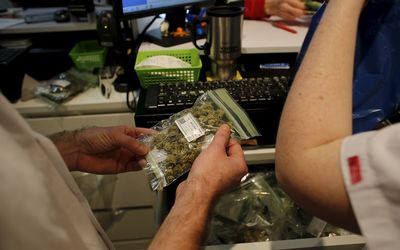THE stalled Medical Innovation Bill, which seeks legality for dagga as a medical therapeutic adjunct and greater freedom for its recreational use, will need significant surgery if it is to become law.
The bill, tabled by the late Mario Ambrosini in 2014, went through Parliament unopposed, but has been wheel-spinning ever since. It is hopelessly bogged down — primarily over the liberalisation of dagga for commercial and recreational use.
Charles Parry, director of the alcohol, tobacco and other drug research unit at the South African Medical Research Council, says that before medicinal dagga can be made more widely available — for conditions, such as chronic pain, in which the evidence of benefit is strongest — policy makers will need to consider issues such as safe supply and regulation.
Arvitha Doodnath, a legal researcher at the Helen Suzman Foundation, maintains that "marijuana is not the serious threat that most governments want us to believe. There are legalised drugs that cause more harm than marijuana, such as alcohol and tobacco."
She quotes one estimate that more than 158-million people worldwide use dagga, but concedes that there are social and physical side effects, particularly among adolescents and pregnant women.
"But the science shows that marijuana can be mixed in various quantities to achieve a certain desired result. Legalising and regulation is preferable to a black market," Doodnath says.
Central Drug Authority deputy chairman David Bayever describes the bill as confusing, "as it proposes medicinal use and other uses, such as commercialisation of the plant, which we believe would add to more social problems that the country is facing".
Gerbus Muller, clinical pharmacologist and toxicologist and a former lecturer at the University of Stellenbosch’s faculty of medicine and health sciences, believes it would be "catastrophic" to make dagga unregulated and freely available in its raw form, as suggested in the bill.
Traditional medicine is big business, says Muller, who estimates that about half of all the medicines used in SA are traditional or alternative medicines, including dagga.
Svetoslav Bulatov, a medical doctor and homeopath, is opposed to all mind-altering drugs as a treatment for illness. "We don’t need dagga in any form as a therapy. I am not in favour of any herbal mind-altering substances like ibogaine, ayahuasca, peyote, salvia, betel nut, jimsonweed, coca leaves."
Bulatov believes dagga is a dangerous and addictive drug and a gateway to narcotics abuse. He says he is all for research into natural remedies, but such investigation must be guileless. He worries that the hype around dagga as a wonder treatment for dread diseases, such as cancer and diabetes, masks the "real reason" for the rush to legalise it. Parry says the South African Medical Research Council acknowledges the increasing evidence of the value of medical dagga in providing palliative care for various conditions, but the issue should be separated from the legalisation of dagga.
The bill proposes that, in keeping with world standards, one or more research hospitals should be established so that medical innovation can be promoted and can effect change on the legalisation of the medical, commercial, and industrial use of dagga.
Bulatov says reasonable steps have been taken to filter out the narcotic effects in isolating the chemicals that hold health benefits and capturing them in pill, syrup, and injectable form, primarily the Cannabidiol in the plant.
"But you can never retrieve such components in a completely uncorrupted form," he says. "There will be always traces of the unwanted chemical in any extract.
"As small as that contamination might be, it still represents narcotic contamination. The same applies to marijuana especially cultivated to have none of the TCH stimulant or very little of it." Some traditional healers use dagga to diagnose diseases. In his book, Medical Plants and Traditional Medicines in Africa, Abayomi Sofowora recorded that "after taking the drug, the patient talks freely and while in this uninhibited state, he reveals the story of his life, as well as his sickness".
In some cultures, dagga sends the healer into a trance, which allows them to commune and intercede with the patient’s ancestors, who are often thought to be the source of the problems.
Medical marijuana has been approved by the US Food and Drug Administration (FDA) for the treatment of nausea and vomiting in patients undergoing chemotherapy and to stimulate appetite in patients with HIV. It is also used to treat Tourette’s Syndrome; loss of appetite in cancer patients; spasticity in patients with multiple sclerosis; postoperative nausea and vomiting; and the skin condition pruritus, although it does not have FDA approval for these conditions.
Earlier this month, the Australian parliament legalised the growing of dagga for medicinal purposes, with the government calling it "the missing piece in a patient’s journey".
Australian Health Minister Sussan Ley said the law allowed dagga cultivation through a national licensing and permit scheme, opening the way to a safe, legal and sustainable supply of domestically produced product. In SA, a watered-down version of the Medical Innovation Bill could possibly become law, which would allow some easing of the ring-fencing that constrains the use of medical dagga.
The elephant in the surgery room is the apparently insurmountable incompatibility between modern biomedicine and traditional medicine. Both parties understand the need for a closer relationship, but they do not seem to know how to get there.

Medicinal dagga at a dispensary in Tel Aviv, Israel. SA’s Medical Innovation Bill would legalise dagga for medical purposes if the bill were passed into law in its current form. Picture: REUTERS/RONEN ZVULUN
THE stalled Medical Innovation Bill, which seeks legality for dagga as a medical therapeutic adjunct and greater freedom for its recreational use, will need significant surgery if it is to become law.
The bill, tabled by the late Mario Ambrosini in 2014, went through Parliament unopposed, but has been wheel-spinning ever since. It is hopelessly bogged down — primarily over the liberalisation of dagga for commercial and recreational use.
Charles Parry, director of the alcohol, tobacco and other drug research unit at the South African Medical Research Council, says that before medicinal dagga can be made more widely available — for conditions, such as chronic pain, in which the evidence of benefit is strongest — policy makers will need to consider issues such as safe supply and regulation.
Arvitha Doodnath, a legal researcher at the Helen Suzman Foundation, maintains that "marijuana is not the serious threat that most governments want us to believe. There are legalised drugs that cause more harm than marijuana, such as alcohol and tobacco."
She quotes one estimate that more than 158-million people worldwide use dagga, but concedes that there are social and physical side effects, particularly among adolescents and pregnant women.
"But the science shows that marijuana can be mixed in various quantities to achieve a certain desired result. Legalising and regulation is preferable to a black market," Doodnath says.
Central Drug Authority deputy chairman David Bayever describes the bill as confusing, "as it proposes medicinal use and other uses, such as commercialisation of the plant, which we believe would add to more social problems that the country is facing".
Gerbus Muller, clinical pharmacologist and toxicologist and a former lecturer at the University of Stellenbosch’s faculty of medicine and health sciences, believes it would be "catastrophic" to make dagga unregulated and freely available in its raw form, as suggested in the bill.
Traditional medicine is big business, says Muller, who estimates that about half of all the medicines used in SA are traditional or alternative medicines, including dagga.
Svetoslav Bulatov, a medical doctor and homeopath, is opposed to all mind-altering drugs as a treatment for illness. "We don’t need dagga in any form as a therapy. I am not in favour of any herbal mind-altering substances like ibogaine, ayahuasca, peyote, salvia, betel nut, jimsonweed, coca leaves."
Bulatov believes dagga is a dangerous and addictive drug and a gateway to narcotics abuse. He says he is all for research into natural remedies, but such investigation must be guileless. He worries that the hype around dagga as a wonder treatment for dread diseases, such as cancer and diabetes, masks the "real reason" for the rush to legalise it. Parry says the South African Medical Research Council acknowledges the increasing evidence of the value of medical dagga in providing palliative care for various conditions, but the issue should be separated from the legalisation of dagga.
The bill proposes that, in keeping with world standards, one or more research hospitals should be established so that medical innovation can be promoted and can effect change on the legalisation of the medical, commercial, and industrial use of dagga.
Bulatov says reasonable steps have been taken to filter out the narcotic effects in isolating the chemicals that hold health benefits and capturing them in pill, syrup, and injectable form, primarily the Cannabidiol in the plant.
"But you can never retrieve such components in a completely uncorrupted form," he says. "There will be always traces of the unwanted chemical in any extract.
"As small as that contamination might be, it still represents narcotic contamination. The same applies to marijuana especially cultivated to have none of the TCH stimulant or very little of it." Some traditional healers use dagga to diagnose diseases. In his book, Medical Plants and Traditional Medicines in Africa, Abayomi Sofowora recorded that "after taking the drug, the patient talks freely and while in this uninhibited state, he reveals the story of his life, as well as his sickness".
In some cultures, dagga sends the healer into a trance, which allows them to commune and intercede with the patient’s ancestors, who are often thought to be the source of the problems.
Medical marijuana has been approved by the US Food and Drug Administration (FDA) for the treatment of nausea and vomiting in patients undergoing chemotherapy and to stimulate appetite in patients with HIV. It is also used to treat Tourette’s Syndrome; loss of appetite in cancer patients; spasticity in patients with multiple sclerosis; postoperative nausea and vomiting; and the skin condition pruritus, although it does not have FDA approval for these conditions.
Earlier this month, the Australian parliament legalised the growing of dagga for medicinal purposes, with the government calling it "the missing piece in a patient’s journey".
Australian Health Minister Sussan Ley said the law allowed dagga cultivation through a national licensing and permit scheme, opening the way to a safe, legal and sustainable supply of domestically produced product. In SA, a watered-down version of the Medical Innovation Bill could possibly become law, which would allow some easing of the ring-fencing that constrains the use of medical dagga.
The elephant in the surgery room is the apparently insurmountable incompatibility between modern biomedicine and traditional medicine. Both parties understand the need for a closer relationship, but they do not seem to know how to get there.





















